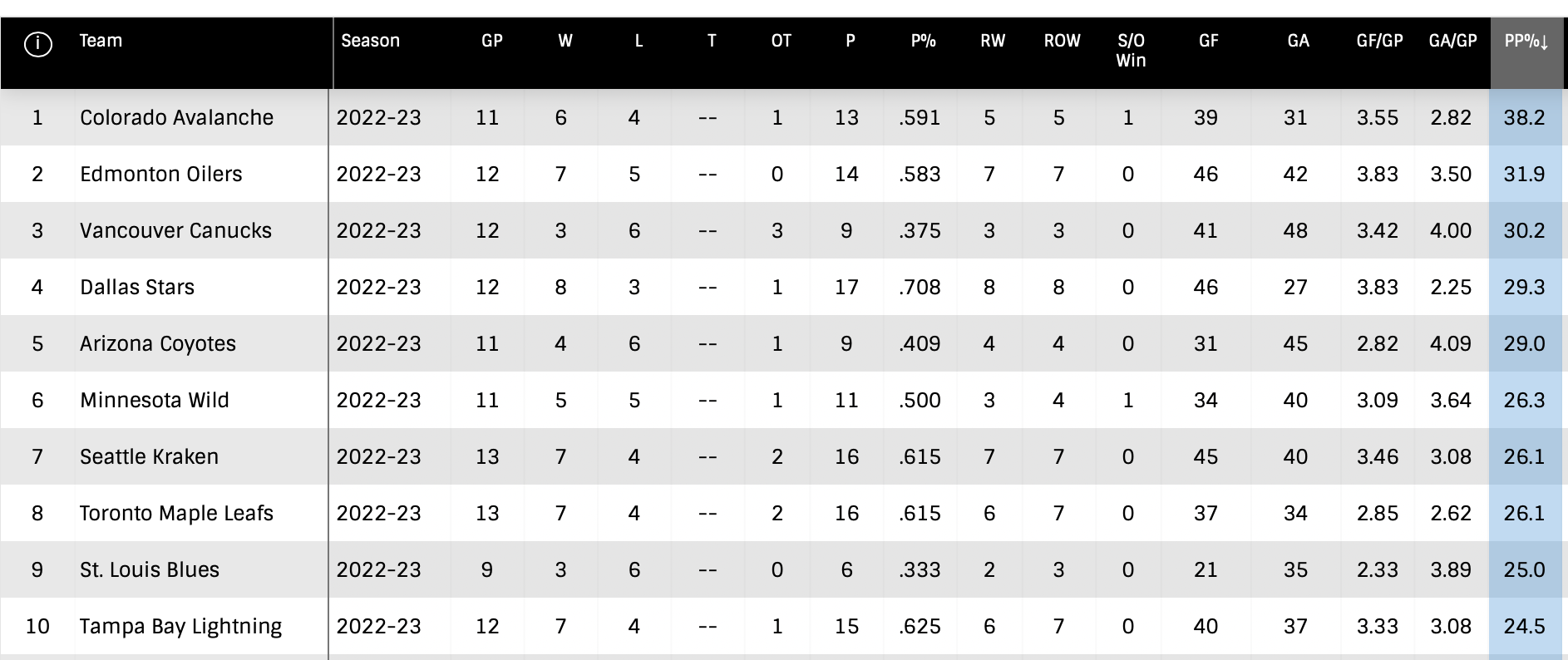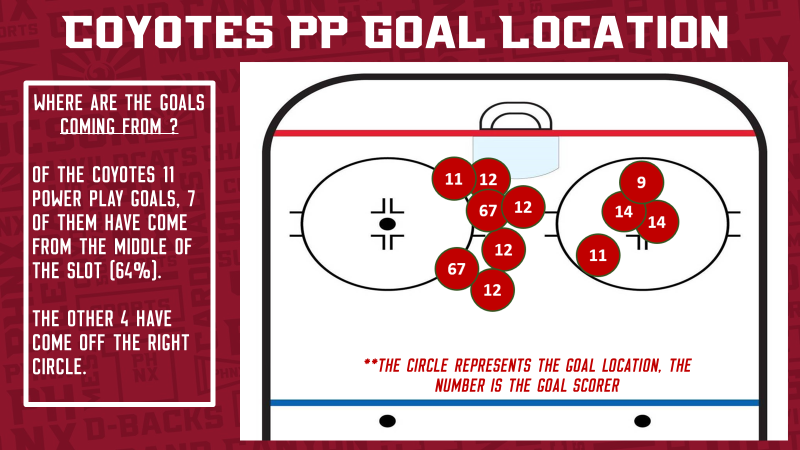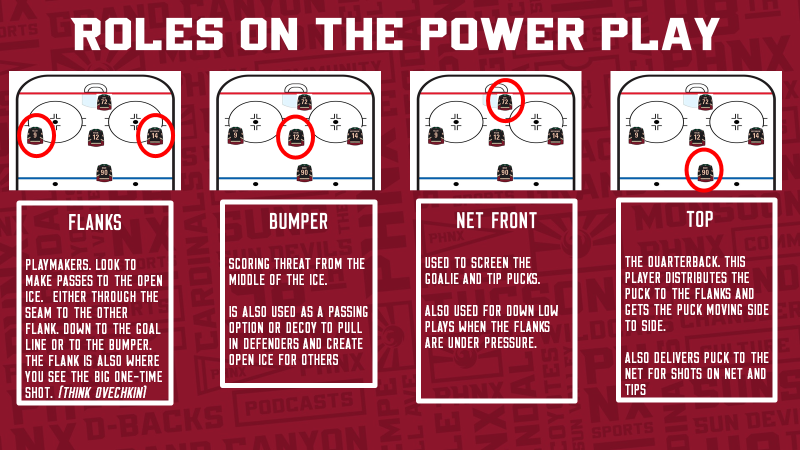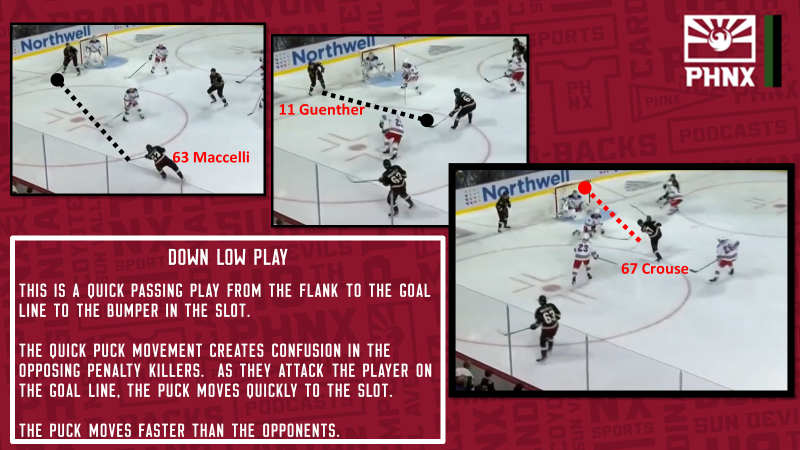© 2025 ALLCITY Network Inc.
All rights reserved.

The Colorado Avalanche, the Edmonton Oilers, the Toronto Maple Leafs and… the Arizona Coyotes. The first three teams are logical choices when you think of elite power-play units in the NHL.
The last one? Not so much, yet 11 games into the season, that is exactly where the rebuilding Coyotes find themselves, ranked fifth in the NHL with 11 power-play goals in 38 chances.

“It’s a young season,” coach André Tourigny cautioned. “Luck has been on our side sometimes. That’s the way it goes. Sometimes, it will be the reverse but as long as we stick with what we believe is the right recipe we will be fine.”
Cory Stillman, the assistant coach who runs the power play, declined an interview for this story, deferring to Tourigny. So PHNX Sports’ Steve Peters and I spoke to Tourigny, defenseman Shayne Gostisbehere, forward Nick Ritchie and defenseman JJ Moser to get a better sense of why the Coyotes’ aforementioned “recipe” has been producing haute cuisine early in the 2022-23 season.
The greatest reason is one that coaches and players preach all of the time.
“I think it has just been about simplifying things,” Gostisbehere said. “We’re all in our spots for specific reasons and we all have certainty in what we’re doing so we just have to execute the game plan and read what the PK is doing against us.”
Power-play simplicity was a focus for Stillman, Tourigny and the coaching staff this offseason. The power play that the Coyotes employed under former assistant coach Phil Housley was complex, with multiple concepts. The current one is not.
Tourigny and his staff held meetings to discuss the power play this summer. Everybody brought ideas and analysis to the table, including assistants Mario Duhamel and John Madden, a pair of penalty-kill specialists who outlined which facets of power plays are the hardest to defend.
The staff also watched a lot of playoff hockey together to see what worked for other teams, and when Tourigny served as an assistant coach for Canada at the World Championship, he was in charge of the power play so he dove into it and studied a lot of successful teams.
“We put a lot of work into it to make sure it was as simple as possible,” Tourigny said. “We did not want to write down 10 points. Honestly, we brought four points. We said ‘These are the four things we want to do well and those four things are nonnegotiable.’”

One of the first changes that the Coyotes made was to move Gostisbehere from the top of the power play to the flank because they wanted a shooter in that spot to get more pucks to the net. Gostisbehere had never played that spot before.
“I played the top for nine years and I’ll be honest, when I had dinner with Bear before the season started and he told me I was gonna be on the wall, I thought he was joking,” Gostisbehere said. “I was definitely not used to it, the spacing, where people are, where my outlets are.
“When you’re up top, you’re used to just facing the play. You can see everything so it’s a lot easier. On the wall, you have to always look side to side because you’ve got to know where this guy is, where that guy is. I wasn’t comfortable at first, but it’s gotten better as I get more reps on it.”
Gostisbehere does not have an Alex Ovechkin or Steven Stamkos caliber shot, but he does have a hard, accurate delivery. He has also brought another facet to the position. He is an excellent passer and the deception of whether he is going to shoot or pass has produced hesitation in opponents and success for the Coyotes. Which option he chooses depends on what the defense is doing.
“You saw it a little [against Winnipeg] where their guys were sitting on me a little more so it’s just about adjustments,” he said. “That’s what makes good power plays elite. You look at Washington, you look at Tampa, they’ve been together for 10 years. Everyone knows Ovi’s going to one-time it, but he’s still scoring. I think it’s the way you adjust to their adjustments that make you not only a good power player, but an elite power play.”

Power play nuts and bolts
Another surprise on this power play this season has been the elevation of JJ Moser to the first unit. Moser has assumed Gostisbehere’s role at the top — and Gostisbehere has provided plenty of pointers for that role — but Moser also has a key role at times on the breakout, carrying the puck initially.
“The breakout is the first thing, just building it up, trying to get a good pace on it and push them back,” Moser said. “It just sets up a good [offensive-zone] entry. We try to keep it pretty simple. I just push them back on the first wave, then drop it so that [Clayton Keller] and [Travis] Boyd can come with a lot of speed and try to get into the [offensive] zone.”
Moser’s role once the Coyotes gain the zone is to serve as a distributor, finding the open man and keeping the puck moving quickly so that the defense cannot get settled into position.
“How many goals did Adam Fox have on the power play last year?” Tourigny asked about the New York Rangers’ power-play quarterback, who had zero. “But Chris Kreider had 20-some [26]. Why? Because Fox found Kreider in front of the net for the tip or whatever.
“Sure, we want a guy who can score from up there, but Mo’s number one job is playmaking. He needs to be able to open the ice, to create space for either Kells or [Matias Maccelli]. Mo is a really good puck mover. He has that quality of being able to slide on the blue line, open the ice and find the right option to relieve the pressure.”
When you look at the Coyotes’ power-play personnel overall, other than Gostisbehere, the faces do not scream elite unit. Think about the Capitals’ personnel (when healthy) of Ovechkin, Evgeny Kuznetsov, Nicklas Bäckström, John Carlson and TJ Oshie, or the Lightning’s top unit of past years with Stamkos, Victor Hedman, Nikita Kucherov, Brayden Point and Alex Killorn. The Coyotes’ unit does not compare with those units, but it has something that Tourigny’s staff feels is critical to success.
“When we look at all the other teams, the key is to have the right players at the right place, it’s not to have five good players,” he said. “It’s to have the right blade on the right side, and the right mindset and everybody being in sync.
“In order to be in sync, you need to play on the right side, you need to have the right skill set to be in the right spot. Ghost has the right skill set to be where he is because he can make a pass and he can shoot hard. If it’s Maccelli in that spot, it’s not the same at all. Maccelli is a really good player, but he doesn’t have the same shot. It’s the same thing for Ritchie in the slot. Same thing for Boyds on the goal line.”

Another key aspect to the Coyotes’ stripped-down power play is the importance of puck movement and reads. Instead of having to process what some overlaid structure preaches, the players are allowed a little more freedom.
“They’re letting us play,” Ritchie said. “We don’t have any set plays; we’re just kind of feeding off each other. We have our fundamentals but then we’re just kind of reading off it and shooting; finding the open man.
“I think when you’re thinking too much on the power play is where it goes bad, and probably our struggles, not that there’s been too many, have been that. When we get back to just kind of moving around, we seem to get a lot better.”

Ritchie has been a revelation in the bumper position with a team-high four power-play goals, which is tied for eighth in the NHL, but his success is not as simple as having a big body in front of the net.
There is very little time for the bumper to read, react and make a play. Because of the bumper’s position on the ice, defenses must collapse on that position quickly or risk giving up a high-danger scoring chance.
“We said it last year,” Tourigny said. “He’s underrated in terms of making plays. He can make plays because he can read the play well and be there to relieve the pressure all the time.”
Ritchie said he has a comfort level in that spot.
“I’ve been there before in my career a little bit,” he said. “Just getting the reps and getting success and getting confidence in there is the main thing, and that’s happened.
“We’ve scored a lot and we’ve got some great playmakers. Obviously Kells and Ghost have made some good plays through the middle and I think just them sucking guys in gives you room in the middle. Guys that are deceptive and can kind of look guys off, get the penalty killer’s stick to move one way or the other, I think that makes a big difference on finding that little area in the middle.”
That’s not the only way in which the Coyotes are generating scoring chances, however. Again, their success is predicated on quick movements that open up the defense, finding the open man and getting pucks to the net from prime positions in the offensive zone.


The Coyotes are also getting contributions from their second unit.
“If you look at the other unit, Celli is elite on the side, Crouser is a really good shooter and has a good release in the middle, and you have a Guenther, who’s not afraid to make a pass or take a shot, but he can screen the goalie, too,” Tourigny said. “He’s not afraid to go in front.
“I think overall, we move the puck well, our entry is good, our loose puck recovery is good, but we need to use everybody. It has to be a unit of five. When we start to be a unit of three or a unit of four we’re not as good so we need to find Ritchie in the middle. We need to find Boydy on the goal line. We need to find Guenther on the goal line. We need to find Crouser in the middle. That’s what makes the difference. If it’s always the same player touching a puck, now you get predictable. We need to be predictable for our team, but unpredictable for our opponent.”
Moser highlighted one more key to success that teams harp on regularly.
“The biggest part is the communication between the players,” he said. “You have to talk with your teammate and ask him, ‘Hey, what’s the position that you feel comfortable in? What’s the situation that you like? Where can you make your plays? And where do you feel uncomfortable? What passes do you want? What passes don’t you want? Where are you feeling under pressure,’ and kind of figure that out.”

The Coyotes have finished among the NHL’s top 10 power plays just three times in their 25 previous seasons. In their first season in the Valley, they finished fourth in an era when power-play percentages were much lower than they are now. Only three teams finished above 20 percent that season.
When Newell Brown was an assistant coach on Dave Tippett’s staff, the Coyotes finished fourth and seventh in consecutive seasons (2013-14 and 2014-2015) with percentages of 19.9 and 20 percent.
| Season | Power play percentage | NHLrank |
| 1996-1997 | 18.1% | 4th |
| 1997-1998 | 14.8% | 14th |
| 1998-1999 | 12% | 26th |
| 1999-2000 | 11.9% | 27th |
| 2000-2001 | 16.6% | 14th |
| 2001-2002 | 15.6% | 14th |
| 2002-2003 | 14.3% | 22nd |
| 2003-2004 | 14.3% | 26th |
| 2005-2006 | 17.7% | 19th |
| 2006-2007 | 16.5% | 22nd |
| 2007-2008 | 18.6% | 11th |
| 2008-2009 | 14.5% | 28th |
| 2009-2010 | 14.7% | 28th |
| 2010-2011 | 15.9% | 23rd |
| 2011-2012 | 13.6% | 29th |
| 2012-2013 | 14.8% | 25th |
| 2013-2014 | 19.9% | 4th |
| 2014-2015 | 20% | 7th |
| 2015-2016 | 17.7% | 20th |
| 2016-2017 | 16.2% | 26th |
| 2017-2018 | 16.9% | 26th |
| 2018-2019 | 16.3% | 26th |
| 2019-2020 | 19.2% | 18th |
| 2020-2021 | 20.8% | 13th |
| 2021-2022 | 13.9% | 30th |
| *2022-2023 | *29% | *5th |
Again, it’s a long season, but the early returns from the power play have been, well, special.
“We’ve been pretty good at it,” Tourigny said. “It’s not perfect. We still need to work a little bit on a few things, but right now, everything’s clicking.”
Top photo via Getty Images: Shayne Gostisbehere celebrates his power-play goal against the Toronto Maple Leafs with teammates Nick Ritchie, Clayton Keller and JJ Moser on Oct. 17 in Toronto.
Follow Craig Morgan on Twitter
Comments
Share your thoughts
Join the conversation



